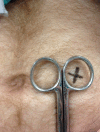Methods for siting emergency stomas in the absence of a stoma therapist
- PMID: 24780787
- PMCID: PMC4474052
- DOI: 10.1308/003588414X13814021679717
Methods for siting emergency stomas in the absence of a stoma therapist
Abstract
Introduction: Stomas often have to be sited in emergencies by trainees who may have had little training in this. Emergency stomas and stomas where the site has not been marked preoperatively by a stoma therapist are more prone to complications. These complications may severely affect a patient's quality of life. Advice in the literature on how to best site stomas is conflicting. We compared two easy anatomical methods of siting stomas to sites chosen by a stoma therapist and looked at how this site was affected by the patients' body mass index (BMI).
Methods: Patients undergoing elective colorectal surgery were seen either pre or postoperatively. Each patient's BMI was recorded and the positions of three different potential stoma positions (site G: the gold standard, marked by a stoma therapist; site S: marked using a pair of scissors against the umbilicus; site H: halfway between the umbilicus and anterior superior iliac spine) were compared.
Results: The two fixed anatomical methods described (method S and method H) both gave poor results. The most common reason for poor siting was the proximity of a skin crease. There was a statistically significant correlation between the patient's BMI and the laterality of the gold standard site.
Conclusions: The two simple anatomical methods described here do not provide a shortcut to effective siting. A more effective method may be calculating the laterality of the site using the patient's BMI, and then moving up/down to avoid a skin crease and improve the patient's view for changing the bag. This deserves further study.
Figures
References
-
- Shabbir J, Britton DC. Stoma complications: a literature overview. Colorectal Dis 2010; 12: 958–964. - PubMed
-
- Arumugam PJ, Bevan L, Macdonald L et al A prospective audit of stomas – analysis of risk factors and complications and their management. Colorectal Dis 2003; 5: 49–52. - PubMed
-
- Nastro P, Knowles CH, McGrath A et al Complications of intestinal stomas. Br J Surg 2010; 97: 1,885–1,889. - PubMed
-
- Macdonald A, Chung D, Fell S, Pickford I. An assessment of surgeons’ abilities to site colostomies accurately. Surgeon 2003; 1: 347–349. - PubMed
-
- Sjӧdahl R, Anderberg B, Bolin T. Parastomal hernia in relation to site of the abdominal stoma. Br J Surg 1988; 75: 339–341. - PubMed
Publication types
MeSH terms
LinkOut - more resources
Full Text Sources
Other Literature Sources




